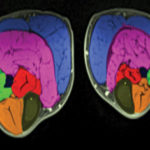
Study participant demonstrating the dynamic weight-bearing fondu test. (Picture from Steinberg et al. MPPA, 2017; with permission.)
By Katie Bell
Textured insoles worn in walking shoes can improve the dynamic postural balance of young ballet dancers both with and without previous injury, according to study data from Canberra, Australia, which also suggested textured insoles can be useful as a routine intervention.
Lead author Nili Steinberg, PhD, associate professor of health at the University of Canberra, Australia, and Wingate College of Physical Education and Sports Sciences, Wingate Institute in Netanya, Israel, said, “Most dancers and dance teachers are continuously trying to discover methods that will improve dynamic postural balance ability, knowing better postural stability may reduce the risk for musculoskeletal injuries.”
The 26 dancers (14 girls), who were full-time elite classical ballet students from the Australian Ballet School in Melbourne, were aged 13 to 19 years. Steinberg and colleagues divided them into two groups matched by sex and class level (four levels based on biological age, academic year, and skill/experience); group one wore textured insoles in their walking shoes for at least two hours a day during weeks one to four, and group two wore textured insoles in their walking shoes for the same period during weeks five to eight.
Fourteen dancers sustained an injury (most were to the ankle or foot) in the three months prior to study recruitment; 10 (71.4%) from group one and four (28.6%) from group two. All were fully healed at the study’s start, and injury severity was not significantly different between groups.
The synthetic textured insoles featured four nodules, each 3 mm high and 1 mm in diameter, per square centimeter. The material was cut to fit into the dancers’ own walking shoes, which included all types of shoes worn outside dance classes.
Researchers tested dancers’ dynamic postural balance on the first day of the first week of the study and after four and eight weeks. They also compared at baseline and eight weeks the dynamic postural balance of dancers with a previous injury with that of uninjured dancers.
After measuring dynamic postural balance with an accelerometer during single-leg flexing and extending of the knee (the weightbearing fondu test), the researchers measured average acceleration magnitude (AAM), root mean square acceleration (RMSA), range, and mean frequency (MF), with all parameters analyzed for the mediolateral, anterior-posterior, and vertical axes, and the resultant three directions. With all parameters, smaller values suggest better stability.
Both groups had significantly greater dynamic postural balance after four weeks of insole wear compared with baseline. Group one showed an 11%, 12%, and 15% reduction in AAM, RMSA, and range, respectively, which was significant in the mediolateral direction. Meanwhile, group two showed a 10%, 13%, 22%, and 15% reduction in AAM, RMSA, range, and MF, respectively, in the mediolateral direction. A respective 7%, 27%, and13% reduction in AAM, RMSA, and range in the resultant three directions was evident after wearing the insoles for four weeks compared with baseline in both groups.
The findings were published by Medical Problems of Performing Artists in June.
“Dancers with previous injury showed decreased postural balance ability [decreased AAM, RMSA and range] at baseline compared to the noninjured dancers [although nonsignificant], yet attained similar or better dynamic postural balance following the use of the textured insoles,” Steinberg said. She and her coauthors think the postural balance improvements seen with the insoles were due to increased proprioceptive stimulation.
Jeffrey A. Russell, PhD, AT, FIADMS, assistant professor of athletic training and director of Science and Health in Artistic Performance at Ohio University in Athens, said, “Sources of increased tactile sensation, such as textured insoles, are thought to put an individual’s proprioceptive system on ‘alert,’ thereby making proprioception more responsive in the event of an injury.” (See “Using subsensory noise to improve balance, gait,” LER, May 2016, page 37, and “Sensory-enhancing insoles improve agility performance in recreational athletes,” LER, March 2017, page 15.)
Steinburg and colleagues’ study looked only at elite dancers, and she noted Rein et al in a 2011 Clinical Neurophysiology study compared postural control and ankle position sense of professional ballet dancers with those of amateur dancers and controls, finding professional dancers had better postural balance control at all standing positions.
Russell said less experienced dancers would likely see greater improvement with textured insoles because their less developed proprioceptive systems should respond more than those of more advanced dancers.
He suggested further study, and asked: “Is there twice the benefit when you wear [textured insoles] twice as long? Highly doubtful. What is the threshold of wearing time above which no further benefit is seen? Would the results be better if dancers wore the insoles during dance instead of just in their casual shoes for a couple of hours a day? You can see there are still many questions, and this is the mark of a good research project: it creates more new research questions than it answers.”
Katie Bell is a freelance writer based in New York City.
Sources:
Steinberg N, Tirosh O, Adams R, et al. Influence of textured insoles on dynamic postural balance of young dancers. Med Probl Perform Art 2017;32(2):63-70.
Rein S, Fabian T, Zwipp H, et al. Postural control and functional ankle stability in professional and amateur dancers. Clin Neurophysiol 2011;122(8):1602-1610.





